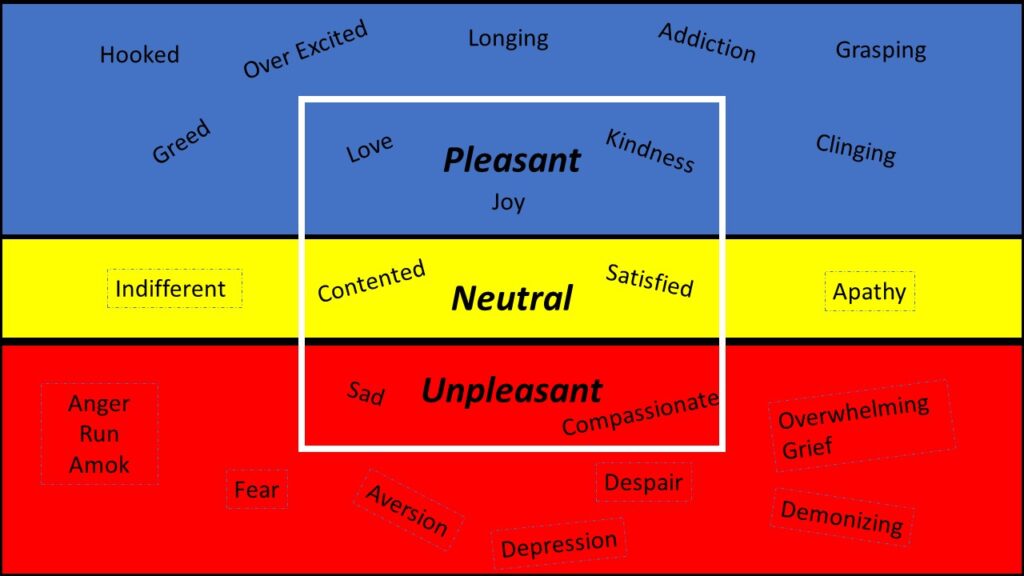
I can look at this picture as pleasant: beautiful fall leaves, unpleasant: raking to do, or neutral: not even noticing it.
Many of us had a very pleasant or a very unpleasant experience on Saturday when the election results were announced. We need to pay attention to everything coming in through our senses. We react to them in different ways. The same thing happened, yet some people felt very unpleasant, and others felt very pleasant. It is not the situation that happens, it is our reaction to it. We need to be careful about what we are taking in and how it will impact us.
Pay attention to what your senses let in the first 20 minutes after you wake up. “That time window is when your subconscious mind is most impressionable and soaks up information like a sponge. Whatever you hear, see or are exposed to in that first 20 minutes will affect you and set the tone for the rest of your day.” Kimanzi Constable
Research has found that your mood in the afternoon is influenced by what you take in the first 20 minutes of the day. So you may want to look at what you are taking in during the first twenty minutes. You may want to readjust your routine so you are not reading the news taking in the negative, or allowing yourself to get stressed out looking at your to do list.
Whenever we see, hear, taste, smell or feel something, we unconsciously label it as pleasant, unpleasant or neutral. Since we typically ignore the neutral, our lives are filled with vicissitudes: pleasure and pain, gain and loss, fame and disrepute, and praise and blame.
“When we are paying attention, we may notice that the vast majority of our lives are spent in the feeling tone of neutral – neither pleasant nor unpleasant. However, it’s the emotionally charged experiences that we remember most. This makes life seem like a rollercoaster ride defined by great heights of joy and deep pits of discouragement. Noticing the neutral more often can be very useful. Neutral experiences can even become a place of refuge when we are in pain or feeling overwhelmed, but we rarely fully appreciate them. At the very least, if we habitually ignore the neutral, we are cut off from huge swaths of our experience.” Thich Nhat Hanh
The neutral is like the non-toothache. We don’t ever spend time to say, “I don’t have a toothache.” Unless we just had a toothache that has just gone away. But our awareness of that neutral feeling doesn’t last very long.
We often think of the feeling tone of pleasant, unpleasant or neutral coming from the person, the object or the experience itself, but in reality, it comes from our perception of the person, object or experience. Purple is not inherently pleasant; it is my perception of purple that makes it pleasant for me. I unconsciously assign the color purple as giving me pleasure. Just as I may think the color orange is unpleasant. It is not the color, but my perceptions of the color that make me feel unpleasant.
The same thing happens when we see people. Even if they have done nothing, we sometimes assign an unpleasant feeling tone to a person or group of people. I was raised on the South Side of Chicago, so I was raised to be afraid of black males. So just seeing a black male gives me an unconscious unpleasant feeling tone. The negative feeling tone is due to fear. I may not consciously feel the fear, but I unconsciously feel something negative. And that is going to impact what I think, what I say and how I treat that person. That is where mindfulness comes in.
“Mindfulness is like a net that catches proliferating, automatic reactions.” Ajahn Chah
By strengthening our mindfulness, we become aware of the feeling tone sooner, hopefully as soon as it begins to arise. We notice it before we act on it.
Every experience begins with a contact with an object or person. Through that contact, a feeling tone arises; it could be unpleasant, pleasant, or neutral. The feeling tone creates an intention. The intention of an unpleasant feeling tone is aversion, to push away. The intention of a pleasant feeling tone is desire, to hold onto. And a neutral feeling tone is to ignore. And our intentions drive our thoughts, words and actions.
We want to notice the feeling tone when it first arises, so we can respond instead of react. But feeling tones can be quite subtle. We often don’t notice the pleasant feeling tone until it is a 5 on a scale of 1-10. On the other hand, we notice the negative as soon as it is -1. By becoming aware of the feeling tone, we can stop and take skillful action to keep us in our window of tolerance. When you are in your window of tolerance, your brain is functioning well: you can reflect, think rationally, make clear-headed decisions, handle emotions without losing control, and feel safe. When you are outside your window of tolerance, you are likely to flip your lid.
If we are aware the feeling tones that arise, we may be able to transform ourselves. It is the feeling tone keeps us hooked into our conditioned behavior of craving and aversion more so than the emotions. We want more of what feels pleasant because when the pleasant ends, it can feel unpleasant. We don’t want what feels unpleasant, so we push it away or cover it up with short term pleasures. Then we contract into a feeling of poor, poor pitiful me, or we blame others and attack. We often remain unaware of anything that feels neutral.
Let’s take a look at some emotions and the feeling tones they evoke. The emotions inside the white box are inside your window of tolerance. You are able to make clear-headed decisions and respond skillfully. If you are unaware of the emotions, they may intensify, moving you out of your window of tolerance.

Even pleasant emotions can cause us to act unskillfully if we allow them to get too intense. I love watching my grandkids playing together. Rolling around like puppies, laughing and being silly. They look so happy, I hate to tell them to calm down. But standing on the outside, I can see they have gone outside their window of tolerance and one or both will get either hurt feelings or physically hurt as they were too over excited.
Even if the feeling tone is neutral, we have to watch the intensity. If we allow it to intensify outside of our window of tolerance, we end up with indifference or apathy. Boredom comes from not paying attention to and fully experiencing the neutral moments.
When you are in a negative mood, don’t do anything. Anything you do, say or think will be negative in some way because the unpleasant feeling tones put us on our hamster wheel of reactivity. Sometimes causing us to spin further and further out of control. I may have an unpleasant feeling tone due to watching the news. And because I am unaware of it, it can impact my thoughts. All of a sudden, my husband does something that would be a minor irritation. But because of the negative feeling tone I have, I blow it out of proportion and get really angry. Since I am already on my hamster wheel of reactivity, anything he says or does will just make things worse.
So, you see, the problem is not what we perceive as pleasant or unpleasant, but our reaction. Our reaction leads to thought chains and those thought chains lead to emotional stress. If we are mindful, we see that those feeling tones are not permanent. We don’t have to do anything but be aware of them. Once we are aware, they loosen their hold over us. And eventually they pass away of their own accord. If they don’t pass away it is because we are feeding them with our story-lines.
We cannot avoid experiencing pleasant, unpleasant or neutral feelings. They just happen naturally. Mindfulness of feeling tones can give us the space we need so we take skillful actions and refrain from unskillful ones. May you be aware of your feeling tones.